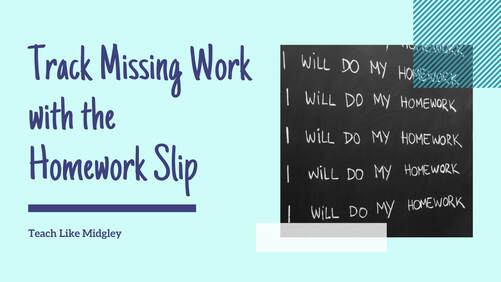Track Missing Work with the Homework Slip
Teaching middle school, students are in and out of your classroom all day. You see each student for maybe 50 minutes. Maximizing instruction time is key. So how do you keep track of who turns in their homework, and who doesn’t?
Let’s face it, having 130 students makes it hard to have a cute chart that shows every student with their own clip to move. It just doesn’t happen that way in middle school.
Having a turn in tray helps, but it’s too easy for that student to walk on by, or pretend they “forgot” they were supposed to turn in their homework.
After trying every trick I could think of, I finally landed on a super simple system that actually WORKS.
In this post, I’m going to share with you how I collect homework, and the simple system I use for tracking missing assignments.
Let’s face it, having 130 students makes it hard to have a cute chart that shows every student with their own clip to move. It just doesn’t happen that way in middle school.
Having a turn in tray helps, but it’s too easy for that student to walk on by, or pretend they “forgot” they were supposed to turn in their homework.
After trying every trick I could think of, I finally landed on a super simple system that actually WORKS.
In this post, I’m going to share with you how I collect homework, and the simple system I use for tracking missing assignments.
Collecting Homework
When students enter my classroom, the first routine is for them to read and follow the directions on the board. These directions will tell them where to sit, what materials they need, a quick do-now task, and what homework they should have sitting on their desktop.
When the bell rings, I close my door and immediately greet my students. Right away, I begin to walk around the classroom collecting homework from each individual student. As I do this, students are finishing up their do-now task and I am asking quick review questions from what we’ve already learned.
Many teachers say that collecting work themselves takes too much time. Some teachers make it a student job. But not me – this is actually the key to stress-free assignment tracking.
The directions on the board always remind students to place their homework on the corner of their desk for me to collect. But the board doesn’t just say homework, it needs to include the name of the actual assignment. This will instantly eliminate the inevitable question: What homework?
If a student does not put their homework on their desktop, then guess who is there with a smile and a reminder – ME. Personally collecting homework also gives me a quick snapshot of who had their homework, and who didn’t.
Most importantly, this method requires each student to be accountable for themselves. They have to look me in the eye when they don’t have it. I realize some may see this as intimidating. But it’s not. It’s meant to remind each and every student that Yes, I do care and Yes, I do expect you to do the work.
Now here’s an important point to remember: seriously questioning a student in front of their peers CAN be intimidating and can take up a lot of time.
This is where the homework slip comes in to play.
When the bell rings, I close my door and immediately greet my students. Right away, I begin to walk around the classroom collecting homework from each individual student. As I do this, students are finishing up their do-now task and I am asking quick review questions from what we’ve already learned.
Many teachers say that collecting work themselves takes too much time. Some teachers make it a student job. But not me – this is actually the key to stress-free assignment tracking.
The directions on the board always remind students to place their homework on the corner of their desk for me to collect. But the board doesn’t just say homework, it needs to include the name of the actual assignment. This will instantly eliminate the inevitable question: What homework?
If a student does not put their homework on their desktop, then guess who is there with a smile and a reminder – ME. Personally collecting homework also gives me a quick snapshot of who had their homework, and who didn’t.
Most importantly, this method requires each student to be accountable for themselves. They have to look me in the eye when they don’t have it. I realize some may see this as intimidating. But it’s not. It’s meant to remind each and every student that Yes, I do care and Yes, I do expect you to do the work.
Now here’s an important point to remember: seriously questioning a student in front of their peers CAN be intimidating and can take up a lot of time.
This is where the homework slip comes in to play.
The Homework Slip
So I created a Homework Slip. If a student doesn’t have their completed work for ANY reason, they are required to fill out and submit the homework slip instead.
The Homework Slip is a way for students to give their explanation without embarrassment. It is also a reminder to the student of their responsibility. When collecting homework, I can take a quick peak at the slip, and if needed, I can have a private chat with the student later.
These slips are kept in a tray close to the door, where students have easy access to them.
I gather up all the completed homework assignments and Homework Slips. They all go in my tray on my desk and I continue on to begin my lesson.
The Homework Slip is a way for students to give their explanation without embarrassment. It is also a reminder to the student of their responsibility. When collecting homework, I can take a quick peak at the slip, and if needed, I can have a private chat with the student later.
These slips are kept in a tray close to the door, where students have easy access to them.
I gather up all the completed homework assignments and Homework Slips. They all go in my tray on my desk and I continue on to begin my lesson.
Secret Powers of the Homework Slip
On the Homework Slip, there is a section where students are to write their reason for why they are not turning in their homework. I will not collect the slip until this portion is filled out, because it is the most important.
When grading, I will keep all the Homework Slips in a stack next to the graded assignments. I enter the grades in the grade-book as usual. Then I pick up the stack of Homework Slips.
In the comments section of the student’s grade, I will quote the student’s reason for not turning in their assignment. I write the following:
Student States: “student quote written verbatim”
Now the genius part of this is when I print a student grade report, which is what I use when I conference with students and parents.
When a parent sees their child has not turned in work, the immediate question is:
Why isn’t my child turning in their work?
And that question is directed at me. I simply point to the comment section of the report, and explain to the parent:
Here are the reasons your child says they were unable to turn in their work.
The attention and responsibility is immediately turned from me, to the student.
I have found this to be a great help in focusing on how the parents and I can work together to help their child get their work turned in on time.
When grading, I will keep all the Homework Slips in a stack next to the graded assignments. I enter the grades in the grade-book as usual. Then I pick up the stack of Homework Slips.
In the comments section of the student’s grade, I will quote the student’s reason for not turning in their assignment. I write the following:
Student States: “student quote written verbatim”
Now the genius part of this is when I print a student grade report, which is what I use when I conference with students and parents.
When a parent sees their child has not turned in work, the immediate question is:
Why isn’t my child turning in their work?
And that question is directed at me. I simply point to the comment section of the report, and explain to the parent:
Here are the reasons your child says they were unable to turn in their work.
The attention and responsibility is immediately turned from me, to the student.
I have found this to be a great help in focusing on how the parents and I can work together to help their child get their work turned in on time.
Ready to Roll Materials
Now that you know about this super simple, effective tracking system, it’s time for you to go put it into practice!
The Homework Slip is so simple and relieves so much stress! You can easily create your own to fit your needs. But if you are looking for a done-for-you solution, then be sure to check out my Homework Slip that comes in two editable versions to fit your needs!
The Homework Slip is so simple and relieves so much stress! You can easily create your own to fit your needs. But if you are looking for a done-for-you solution, then be sure to check out my Homework Slip that comes in two editable versions to fit your needs!
You May Also Like...
Let's Connect...

Welcome! I'm Hillary Midgley, a veteran 6th grade teacher.
I create educational materials and develop curriculum for other teachers. I specialize in teaching students how to learn through my Study Skills Curriculum. I have established fundamental classroom systems and structures for teachers to help them streamline their classroom. And my passion is teaching ancient history through engaging activities with foundations in academic skills. Here you will find resources on all of these topics and more. Learn more about me here.
Want more great teaching tips, organization and management ideas?
Visit us on Facebook, Instagram and Pinterest!
Visit us on Facebook, Instagram and Pinterest!
|






